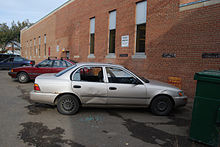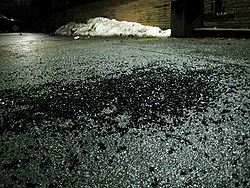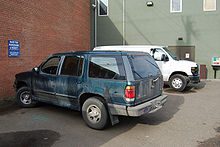- Motor vehicle theft
-
Motor vehicle theft (sometimes referred to as grand theft auto by the media and police departments in the US) is the criminal act of stealing or attempting to steal a motor vehicle (such as an automobile, truck, bus, coach, motorcycle, snowmobile, trailer). Nationwide in the US in 2005, there were an estimated 1.2 million motor vehicle thefts, or approximately 416.7 motor vehicles stolen for every 100,000 inhabitants.[1] Property losses due to motor vehicle theft in 2005 were estimated at $7.6 billion.[2]
Contents
Methods
Some methods used by criminals to steal motor vehicles include:
- Theft of an unattended vehicle without key(s): The removal of a parked vehicle either by breaking and entry, followed by hotwiring or other tampering methods to start the vehicle, or else towing.
- Theft with access to keys: Known in some places as "Taken Without Owner's Consent (TWOC)". The unauthorized use of a vehicle in which the owner has allowed the driver to have possession of or easy access to the keys. Often, this is the adolescent or grown child or employee of the vehicle's owner who, at other times, may be authorized to use the vehicle. May be treated differently, depending on the jurisdiction's laws, and the owner may choose not to press charges.
- Opportunistic theft: The removal of a vehicle that the owner or operator has left unattended with the keys visibly present, sometimes idling.
- Carjacking: Refers to the taking of a vehicle by force or threat of force from its owner or operator. In most places, this is the most serious form of theft, since assault also occurs. In some carjackings, the operators and passengers are forced from the vehicle while the thief drives it away him/herself, while in other incidents, the operator and/or passenger(s) are forced to remain in the vehicle as hostages. Some less common carjackings result in the operator being forced to drive the assailant in accordance with the assailant's demands.[3]
- Fraudulent theft: Illegal acquisition of a vehicle from a seller through fraudulent transfer of funds that the seller will ultimately not receive (such as by identity theft or the use of a counterfeit cashier's check). Many vehicles stolen in this manner are resold quickly thereafter.
Commonly used tools
- Slide hammer puller to break into the door locks and the cylinder lock.
- Multimeters or a test light to find the source of the battery
- Spare wires and/or a screwdriver to connect the battery source to the ignition and starter wires
- A generic rod and hook toolkit to slip between the car window and car frame and to open the lock behind the window. A common one is called the "Slim Jim".
- Many keyless ignition/lock cars have weak[4][5] or no[citation needed] cryptographic protection of the unlock signal. Proof-of-concept "thefts" of top-of-the-line luxury cars have been demonstrated by academic researchers using commercially available tools such as RFID microreaders, but is unknown whether the attack has been used for actual theft.
- A firearm or other weapon such as a baseball bat, or a utility knife or a box cutter to threaten a passenger if inside the car
Vehicles most frequently stolen
The makes and models of vehicles most frequently stolen vary by several factors, including region and ease of theft.
In recent years in the United States, some models often on lists of most frequently stolen vehicles include Toyota Camry, Honda Civic, Honda Accord, Acura Integra, Jeep Cherokee[disambiguation needed
 ], and Cadillac Escalade.[citation needed]
], and Cadillac Escalade.[citation needed]In Thailand, the most frequently stolen vehicles are Toyota and Nissan cars, Isuzu pickup trucks, Honda cars, and Honda motorcycles (2007 data).[6]
In Malaysia, Selangor had the highest number of motor vehicle thefts, ahead of Kuala Lumpur and Johor. Since 2005, Proton models are the most frequently stolen vehicles in the country, with Proton Wira being the highest, followed by the Proton Waja and the Proton Perdana.[7]
Prevention
There are various methods of prevention to reduce the likelihood of a vehicle getting stolen. These include physical barriers, which make the effort of stealing the vehicle more difficult. Some of these include:
- Devices used to lock a part of the vehicle necessary in its operation, such as the wheel, steering wheel or brake pedal. A popular steering wheel lock is The Club.
- Immobilisers, allowing the vehicle to start only if a key containing the correct chip is present in the ignition.
Chances of theft can also be reduced with various deterrents, which give the impression to the thief that s/he is more likely to get caught if the vehicle is stolen. These include:
- Car alarm systems that are triggered if a breaking and entry into the vehicle occurs
- Microdot identification tags which allow individual parts of a vehicle to be identified
- Killswitch circuits are designed to frustrate or slow down the efforts of a determined car thief. Killswitches are often located between crucial parts of the starting system, between the battery source and the coil, or the fuel pump. A car cannot start without first flipping these killswitches to closed position. Savvy car owners hide these killswitches in obscured areas, under the dashboard, beneath the seat, behind a chair, etc.
- Signage on windows warning of the presence of other deterrents, sometimes in absence of the actual deterrents.
- VIN etching
Recovery of stolen vehicles
Recovery rates for stolen vehicles vary, depending on the effort a jurisdiction's police department puts into recovery, and devices a vehicle has installed to assist in the process.
Police departments use various methods of recovering stolen vehicles, such as random checks (ANPR) of vehicles that come in front of a patrol unit, checks of all vehicles parked along a street or within a parking lot using automatic number plate recognition (ANPR) or keeping a watchlist of all the vehicles reported stolen by their owners. Police departments also receive tips on the location of stolen vehicles through StolenCar.com or TWOC.co.uk in the United Kingdom.
In the UK, the DVLA provides information on the registration of vehicles to certain companies for consumer protection and anti-fraud purposes. The information may be added to by companies with details from the police, finance and insurance companies. Such companies are able to provide a car check online service for the public and motor trade.[8]
Vehicle tracking systems, such as LoJack, Automatic vehicle location, or Onstar may enable the location of the vehicle to be tracked by local law enforcement or a private company. Other security devices such as DotGuard microdots allow individual parts of a vehicle to also be identified and potentially returned.
See also
References
- ^ "Motor Vehicle Theft". Crime in the United States 2005 Department of Justice — Federal Bureau of Investigation Release Date: September 2006. http://www.fbi.gov/ucr/05cius/offenses/property_crime/motor_vehicle_theft.html. Retrieved 2009.
- ^ "Property losses". Crime in the United States 2005 Department of Justice — Federal Bureau of Investigation Release Date: September 2006. http://www.fbi.gov/ucr/05cius/offenses/property_crime/motor_vehicle_theft.html. Retrieved 2009.
- ^ FindLaw for Legal Professionals - Case Law, Federal and State Resources, Forms, and Code
- ^ Biham, Eli; Dunkelman, Orr; Indesteege, Sebastiaan; Keller, Nathan; Preneel, Bart (2008), How To Steal Cars — A Practical Attack on KeeLoq, Eurocrypt 2008, http://www.cosic.esat.kuleuven.be/keeloq/
- ^ Bono, Stephen C.; Green, Matthew; Stubblefield, Adam; Juels, Ari; Rubin, Aviel D.; Szydlo, Michael (2005), Security Analysis of a Cryptographically-Enabled RFID Device, 14th USENIX Security Symposium
- ^ 2 ยี่ห้อดัง (โตโยต้า-อีซูซุ) แชมป์รถหาย ตำรวจยกเครื่องลุยโจร - document from Deves Insurance (Thailand) (Thai)
- ^ http://www.mmail.com.my/content/20827-proton-hot-thieves
- ^ Car check
External links
- Auto theft information and statistics
- List of theft prevention devices
- Taken WithOut Consent? UK FREE database of stolen vehicles
- Comparison of Commercially available anti theft solutions
Categories:- Car theft
- Crimes
Wikimedia Foundation. 2010.




